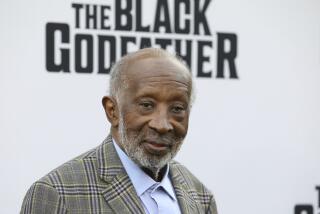R. Stanton Avery; Label Firm Founder
- Share via
R. Stanton Avery, a rags-to-riches entrepreneur who created the first commercially feasible self-sticking, peel-off labels and founded what is now Avery Dennison Corp. to manufacture and market them worldwide, died Friday. He was 90.
Avery, who also headed the Caltech and Huntington Library boards of trustees for many years, died at Huntington Memorial Hospital in Pasadena after a stroke, a company spokesman said.
In 1990, Avery’s Pasadena-based Avery Products Corp. joined the smaller Dennison Manufacturing of Framingham, Mass., to become what is now a multibillion-dollar firm that makes and markets adhesive label products as well as glue sticks, felt markers and other office supplies through such chains as Home Depot and Staples. The company also manufactures self-adhesive postage stamps.
At the time of the merger, Avery had annual sales of $1.7 billion and net income of $86.5 million, and Dennison recorded sales of $771 million and net income of $29.1 million. Last year, Avery Dennison had sales of more than $3.2 billion with 16,100 employees in more than 200 manufacturing and sales locations in 37 countries.
Born in Oklahoma City, Ray Stanton Avery was so poor that he lived in a rented chicken coop and worked as a clerk at the Midnight Mission to put himself through Pomona College. After dropping out for a year to live in China, Avery graduated in 1932 and tried his hand at various business enterprises such as selling smoked Tahitian bananas.
Then, experimenting in a 100-square-foot loft near the Flower Mart, where he worked mornings, Avery cut slits at the ends of a cigar box, filled it with glue and pulled pieces of paper through the slits. The self-sticking label used for price tags and name tags was born.
With $100 borrowed from his fiancee, Avery built a label-cutting machine out of a washing machine motor, parts of a sewing machine and a saber saw. In 1935, he created his company, originally called Kum-Kleen Adhesive Products Co., and paid himself and a handful of employees $20 a week to churn out Kum-Kleen removable price labels.
His adhesives enterprise prospered during World War II when glue for ordinary lick-and-stick labels became scarce. And when the government needed labels for “Mae West” flotation vests that wouldn’t peel off in seawater, Avery turned them out by the millions.
When Avery’s patents lapsed in 1952, other manufacturers rushed into the market. But competition only made Avery’s company grow--doubling sales from $1 million to $2 million in a single year and rising to $5 million by 1956.
Over the years, Avery also introduced self-adhesive label dispensers and in-line label-making and printing machines. Altogether, he amassed 18 patents.
A visionary, Avery delegated management responsibility as early as 1946 to his friend H. Russell Smith, who later served as chairman and president, and in 1964 brought in Charles D. Miller, current chairman and chief executive. Avery remained active in the company until two years ago, when he retired from the board of directors and took the title of founder-chairman emeritus.
The California Manufacturers Assn. named Avery the California Manufacturer of the Year in 1970, and local alumni of the Harvard Business School named him Business Statesman of the Year in 1974.
In business and as a civic leader, Avery was known for his “Stanisms,” or advice to live by. Among them:
“External pressures unite; internal pressures divide.”
“When the going gets rough, you get the best traction.”
“You’re always down on what you’re not up on.”
As Avery’s company flourished, he extended his talents to the community. In 1959, he joined the board of fellows of Claremont Graduate University and later served as chairman. In the 1960s, he became a trustee of the Los Angeles County Museum of Art and a governor of the Performing Arts Council of the Los Angeles County Music Center.
In 1972, he served as president of the United Way of Los Angeles County.
Avery also began a long association with Caltech and the Huntington Library, Art Collections and Botanical Gardens.
He was a Huntington trustee from 1969 until 1991, the last 19 years as chairman, and a Caltech trustee from 1971 until 1985, the last 11 as chairman.
The self-made multimillionaire donated generously to educational and arts institutions. At Caltech, he endowed the R. Stanton Avery Chair for Distinguished Service in 1982 and last year created Avery House, a residence for students and professors to exchange ideas on entrepreneurship.
Avery was widowed twice. His first wife, the former Dorothy Durfee, died in 1964, and his second wife, the former Ernestine Onderdonk, died June 1. He is survived by three children, Judith Avery Newkirk, Dennis Avery and Russell Avery; a sister, Martha van der Veen; 10 grandchildren; and five great-grandchildren.
Memorial services are pending.
More to Read
Inside the business of entertainment
The Wide Shot brings you news, analysis and insights on everything from streaming wars to production — and what it all means for the future.
You may occasionally receive promotional content from the Los Angeles Times.










